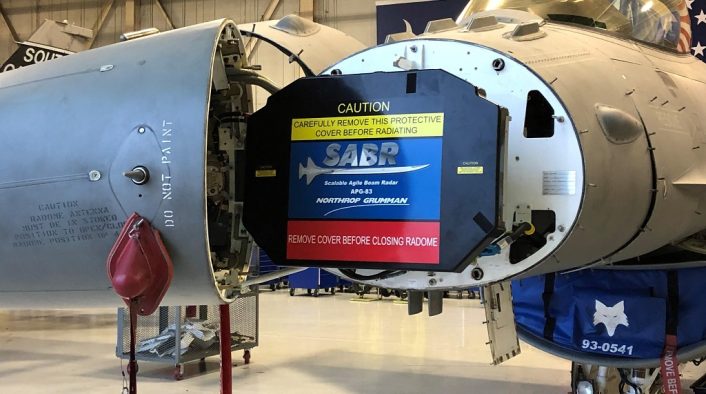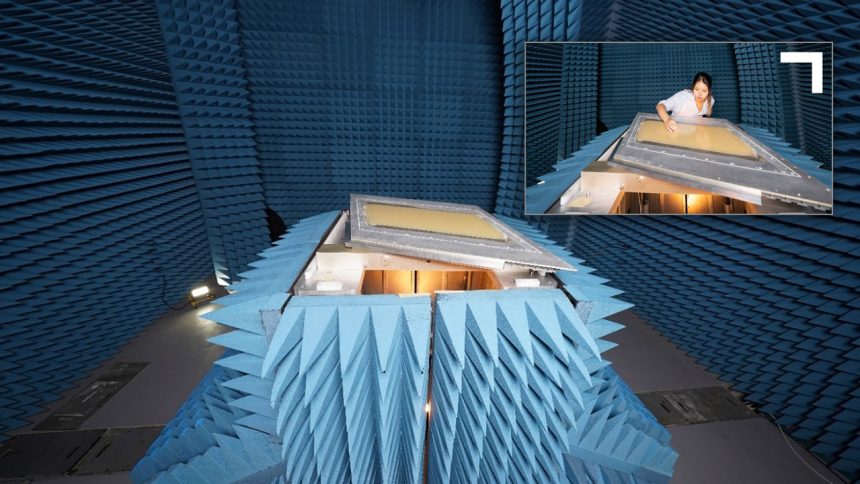Northrop Grumman says EMRIS leverages technologies developed for other programs, combining them with an open architecture and technology from DARPA’s Arrays on Commercial Timescales program.
Northrop Grumman has announced the completion of the first flight test campaign of a new multimode sensor called Electronically Scanned Multifunction Reconfigurable Integrated Sensor (EMRIS). The sensor, first announced in February 2023, can work simultaneously work as radar, electronic warfare (EW) and communications system, says the company.
In the system’s description, Northrop Grumman says that EMRIS is based on a fully digital Active Electronically Scanned Array (AESA) which utilizes technology from DARPA’s (Defense Advanced Research Projects Agency) Arrays on Commercial Timescales program and the now common open architecture standards. The design uses common building blocks and software containerization to allow a rapid, cost-effective production.
“Dozens of successful flights with EMRIS demonstrated the ability to reduce development timelines and lower program costs by leveraging our partnerships with, and advancements across, all military services,” said Krys Moen, vice president for advanced mission capabilities at Northrop Grumman. “Our solutions utilize digital engineering and advancements in microelectronics to provide agile capabilities for both crewed and uncrewed platforms.”
The test campaign
As part of EMRIS’ flights, Northrop Grumman says it demonstrated the ability to quickly leverage technologies developed for other unspecified programs to adapt multiple fielded capabilities into EMRIS. Given the roles EMRIS can perform, candidate programs could be the Multi-role Electronically Scanned Array (MESA) developed for the E-7 Wedgetail, the Integrated Viper Electronic Warfare Suite developed for the F-16 and the Battlefield Airborne Communications Node (BACN) developed for the E-11.
“EMRIS demonstrates the value of a product line designed from the beginning to leverage open, scalable software along with modular digital building blocks to enable a common sensor baseline,” said Northrop Grumman in a statement. “All work is in support of a wide range of existing platform upgrades as well as new emerging opportunities.”
The test campaign was completed “in partnership with government partners and on a government-provided aircraft”, although details were not disclosed. The company added that a second array is entering testing, while two smaller EMRIS apertures are being manufactured for lower cost and size-constrained application demonstrations.

What we know
The details released so far about this sensor are limited. Last year, when it was first announced, Northrop Grumman defined it as an ultra-wideband sensor which exploits the flexibility of a digital AESA to perform functions including radar, electronic warfare and communications simultaneously.
“The sensor’s architecture is easily scaled and reconfigurable, including a variety of mounting configurations, for a wide applicability across platforms and domains,” said Moen. “By developing EMRIS in an open-architecture construct, we can rapidly add new or improved capabilities to increase performance while avoiding redesign. This supports decades of fielded use and continued access to industry best-in-class capabilities for the warfighter.”
The company said the sensor’s design leverages commercial processes and materials, including a 5G tech base, which allow to drive down cost and increase the quality and reliability of the components. Specific platforms which can employ EMRIS were not disclosed, however Northrop Grumman mentioned EMRIS is compact enough to fit also in small drones and that the sensor is intended also for future programs.
The company also said to Air and Space Forces Magazine that EMRIS could be retrofitted to existing platforms or designed into future ones, adding that it has “a wide applicability across platforms and domains” and it can be “either mounted in the nose of an aircraft or integrated within the skin of a platform.”
“Multifunction apertures consolidate multiple functions into a single sensor, decreasing both the number of apertures needed and the size, weight and power requirements for the advanced capabilities,” said Northrop Grumman in last year’s statement. “Sophisticated multifunction apertures like EMRIS can deploy several functions simultaneously.”









